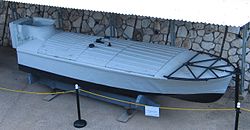Explosive boat MTM
|
The explosive device MTM
|
||||||||||||||||
|
||||||||||||||||
|
||||||||||||||||
|
||||||||||||||||
The explosive vessel MTM (MTM = Motoscafo Turismo Modificato) was the second series-produced explosive vessel of the Italian Navy . It was based on its predecessor, the explosive vessel MT. The predecessor type had fallen out of favor with the Italian naval command, as its sea properties and its seaworthiness were inadequate. From 1941 to 1942 about 100 boats of the MTM explosive boat were manufactured by the Baglietto shipyard (boat hull) in Varazze . The machine parts were again supplied by the company CABI from Milan .
Delivery and test trials
On March 1, 1941, the first experimental construction of the boat was delivered to the Italian Navy. This began immediately with an extensive sea trial and subjected the explosive vessel to several high-performance technical tests, all of which were positive. The naval management was so enthusiastic about this new type that they ordered a further twelve boats in March 1941. However, the dimensions required by the naval command, which would have allowed transport by aircraft, could not be adhered to. Due to the sovereignty of the Allies, the transport of the boats to their destinations by road was only possible to a limited extent overnight. Therefore, the naval management decided very early on to design another type of explosive vessel that could meet this requirement. The solution was to be the MTR , which could be carried piggyback on the upper deck of a submarine.
Setup and missions
The manning and preparation of the full operational readiness of the explosives took place immediately after their delivery. Up until the Armistice of Cassibile on September 8, 1943, the main areas of operation were the Aegean , Adriatic and Ligurian Seas . There, the explosive devices were used for nearby coastal defense, but were only able to achieve selective successes due to the improved positioning technology of the Allies. Their missions took place like raids on Allied anchorages and had the aim of destroying port facilities.
After the armistice, the Kingdom of Italy split into the northern Italian Social Republic (RSI) and southern Italy, which was loyal to the Allies. As a result, the RSI naval units fell under German control, as did the most important production companies in the north. Together with the German crews belonging to the small combat units of the Kriegsmarine , Italian units were also involved in battles with their own compatriots from the south. Production of the MTM explosive device continued until the spring of 1945, albeit at a very low rate. In total, the RSI only had 29 MTM
It is known that this type of explosive device was used by the Israeli Ha'Chulya after 1945 .
Specifications
The specifications of the explosive vessel MTM are almost identical to the explosive vessel MT.The body of the boat, which was again made of wood, was finally assembled by members of the navy after the machine parts had arrived and, following its intended use, received an explosive charge weighing 330 kg from Triolil Valley in the bow area . As in the previous model, the steering position of the explosive vessel was located in the stern area in order to ensure even weight distribution between the explosive charge (bow), pilot and engine (stern). In front of the pilot, all the operating and control instruments of the explosive device were also housed. In addition, the pilot had a magnetic compass and paddles, which should enable a noiseless approach to the enemy.
Intended use
In order to bridge distances that were beyond the reach of the explosive vessel, it was transported by speedboats to the target area and released there.
Individual evidence
- ↑ Information on the Israeli use of explosive boats at palyam.org
- ↑ Harald Fock: Naval small weapons. Manned torpedoes, small submarines, small speedboats, explosives yesterday - today - tomorrow. Nikol, Hamburg 1996, ISBN 3-930656-34-5 , pp. 112-113.
